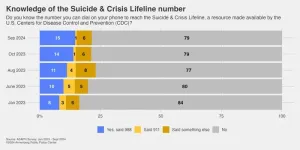(Press-News.org) CORVALLIS, Ore. – In low-risk pregnancies, mothers and children are just as safe with a planned home birth as they are with a planned birth center birth, a national study led by Oregon State University researchers has shown.
The findings, published in Medical Care, contradict doctors’ long-held concerns about home birth, including a recent opinion by the American College of Gynecologists and Obstetricians that describes hospitals and accredited birth centers as the safest places to have a baby. A birth center is a health care facility designed to provide a more natural and home-like environment than a hospital.
OSU scientists analyzed two national registries for community births – planned birth either at home or in a birth center for low-risk pregnancies – in the largest study to examine how the settings compared to each other in terms of health outcomes.
A low-risk pregnancy is defined as a single baby being carried to full term (at least 37 weeks) and positioned with its head down, with no major maternal complications such as diabetes or pre-eclampsia. At least 70% of pregnancies are low risk, said Marit Bovbjerg, an associate professor in the Oregon State College of Health.
Combined, the two registries documented more than 110,000 births from 2012 to 2019, representing all 50 U.S. states, and the data showed no safety difference between home birth and birth center birth.
“Historically, physicians in the U.S. have objected to planned home births but not planned birth center births, even though from both settings you would need to transfer the birthing person to a hospital for any major complications,” Bovbjerg said. “Until now, we’ve had no evidence about home versus birth center outcomes. Our study is the first to provide evidence that these two birth settings are equally safe.”
Bovbjerg and Melissa Cheyney, a professor in the OSU College of Liberal Arts and a licensed midwife, did not directly compare the safety of community settings to hospitals but they note that the bulk of evidence globally, including a U.S. National Academies of Science, Engineering and Medicine report published in 2020, supports the idea that planned community birth is a safe alternative to hospital birth.
“That means that within the U.S., we already had evidence that birth centers were comparable to hospitals for low-risk births,” said Bovbjerg, who with Cheyney co-directs Oregon State’s Uplift Lab. “Our study compared home to birth center and suggests that both community settings are a reasonable choice for low-risk birthing people.”
The scientists note that the rate of home birth in the United States has been increasing over the last two decades, and that 2% of births in the U.S. happen in one of the two types of community settings, which have similar attendants and interventions available but different practice standards, regulatory guidelines and levels of health systems integration.
They added that planned home birth resulted in a lower rate of transfer to hospital than planned birth center birth for reasons that could relate to concern over negative hospital experiences.
“They might fear a loss of continuity of care provider, as well as possible mistreatment and judgment upon arrival at the hospital,” Cheyney said, citing a national care-experience study in which many participants reported mistreatment, including being ignored, scolded, shouted at or subject to an invasive procedure without consent.
“That was especially true for Black and Indigenous people who transferred to a hospital from a planned home birth,” she said. “If previous hostile transfer experiences contribute to a reluctance to transfer, we obviously need to work together to improve the transfer experience. Transfer from community settings is often necessary, and anything that discourages a necessary transfer likely causes harm.”
The collaboration also included researchers from the American Association of Birth Centers, Georgia State University, Frontier Nursing University, the University of Denver and the University of British Columbia.
END
For low-risk pregnancies, planned home births just as safe as birth center births, study shows
2024-11-18
ELSE PRESS RELEASES FROM THIS DATE:
Leaner large language models could enable efficient local use on phones and laptops
2024-11-18
Large language models (LLMs) are increasingly automating tasks like translation, text classification and customer service. But tapping into an LLM’s power typically requires users to send their requests to a centralized server — a process that’s expensive, energy-intensive and often slow.
Now, researchers have introduced a technique for compressing an LLM’s reams of data, which could increase privacy, save energy and lower costs.
The new algorithm, developed by engineers at Princeton and Stanford Engineering, works by trimming redundancies and reducing the precision of an LLM’s ...
‘Map of Life’ team wins $2 million prize for innovative rainforest tracking
2024-11-18
Traditionally, taking inventory of the species in a rainforest requires sending in a team of experts with field guides and binoculars for a multi-day expedition. But the devastating pace of the destruction of the world’s rainforests and increasing urgency to better monitor and protect what remains demand faster, easier, and more efficient approaches.
Several years ago, a Yale-based team devised an alternate approach: they use lightweight, unmanned aerial vehicles (UAVs) to collect this critical biodiversity data in remote areas.
Now they’ve collected ...
Rise in pancreatic cancer cases among young adults may be overdiagnosis
2024-11-18
Embargoed for release until 5:00 p.m. ET on Monday 18 November 2024
@Annalsofim
Below please find summaries of new articles that will be published in the next issue of Annals of Internal Medicine. The summaries are not intended to substitute for the full articles as a source of information. This information is under strict embargo and by taking it into possession, media representatives are committing to the terms of the embargo not only on their own behalf, but also on behalf of the organization they represent. ...
New study: Short-lived soda tax reinforces alternative presumptions on tax impacts on consumer behaviors
2024-11-18
Key Takeaway:
When policymakers enact consumption taxes to raise revenue for the government, consumers who oppose the tax may decrease their consumption more, leading to a reduction in tax revenue.
BALTIMORE, MD, November 18, 2024 – One of the most common assumptions tax policymakers make is that by raising taxes, they will raise revenue for the government. However, a new study that centers on a soda tax in Washington state has reinforced alternative presumptions about tax impacts on consumer behaviors.
Researchers found that when Washington state enacted a tax on soda, it not only generated backlash in the consumer marketplace and political ...
Fewer than 1 in 5 know the 988 suicide lifeline
2024-11-18
PHILADELPHIA – Annenberg Public Policy Center survey data show that public recall of the 988 Suicide & Crisis Lifeline number has grown slowly since the three-digit phone number was introduced in July 2022. Just 15% of U.S. adults are familiar with it, as of September 2024.
Survey respondents who accurately report awareness of the Suicide & Crisis Lifeline number increased significantly from August 2023 (11%) to September 2024 (15%). Those 15% of respondents reported both that they knew the number and, when asked in an open-ended format, said the number ...
Semaglutide eligibility across all current indications for US adults
2024-11-18
About The Study: A total of nearly 137 million adults, representing more than half of all U.S. adults, are eligible for semaglutide therapy. This exceeds the number of adults eligible for statins (approximately 82 million), currently the most prescribed pharmaceuticals among U.S. adults.
Corresponding Author: To contact the corresponding author, Dhruv S. Kazi, MD, MS, email dkazi@bidmc.harvard.edu.
To access the embargoed study: Visit our For The Media website at this link https://media.jamanetwork.com/
(doi:10.1001/jamacardio.2024.4657)
Editor’s Note: Please see the article for additional information, including other authors, author contributions ...
Can podcasts create healthier habits?
2024-11-18
Whether it’s ABC Listen’s Health Report or Mamamia’s But Are You Happy, podcasts have fast become a part of our everyday media consumption. In fact, the average person spends more than five hours a week listening to them. But could listening to podcasts lead to healthier habits?
In the first study of its kind, University of South Australia researchers have explored just this, finding that podcasts can significantly improve health knowledge, increase exercise levels, and boost healthy eating.
Reviewing ...
Zerlasiran—A small-interfering RNA targeting lipoprotein(a)
2024-11-18
About The Study: Zerlasiran, a small-interfering RNA targeting hepatic synthesis of apolipoprotein(a), was well-tolerated and reduced time-averaged lipoprotein(a) concentration by more than 80% during 36 weeks of treatment in patients with atherosclerotic cardiovascular disease.
Corresponding Author: To contact the corresponding author, Steven E. Nissen, MD, email nissens@ccf.org.
To access the embargoed study: Visit our For The Media website at this link https://media.jamanetwork.com/
(doi:10.1001/jama.2024.21957)
Editor’s ...
Anti-obesity drugs, lifestyle interventions show cardiovascular benefits beyond weight loss
2024-11-18
Popular anti-obesity drugs continue to show cardiovascular benefits beyond weight loss, according to several new papers published in JACC, the flagship journal of the American College of Cardiology, that are being simultaneously presented at the American Heart Association’s 2024 Scientific Sessions. JACC is publishing two secondary analyses on the impact of GLP-1 medications in improving cardiac structure and function in heart failure patients and cardiovascular outcomes in those who previously had cardiac bypass surgery, ...
Oral muvalaplin for lowering of lipoprotein(a)
2024-11-18
About The Study: Muvalaplin, an oral small molecule lipoprotein(a) inhibitor, reduced lipoprotein(a) measured using intact lipoprotein(a) and apolipoprotein(a)-based assays and was well tolerated. The effect of muvalaplin on cardiovascular events requires further investigation.
Corresponding Author: To contact the corresponding author, Stephen J. Nicholls, MBBS, PhD, email stephen.nicholls@monash.edu.
To access the embargoed study: Visit our For The Media website at this link https://media.jamanetwork.com/
(doi:10.1001/jama.2024.24017)
Editor’s Note: Please see the article for additional information, including ...


